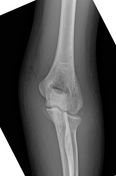Elbow dislocation
- Integral Diagnostics, Shareholder (ongoing)
- Micro-X Ltd, Shareholder (ongoing)
Updates to Case Attributes
Ninety percent of all elbow dislocations are classified as posterior or postero-lateral dislocations, typically found in the non-dominant upper extremity. The most common mechanism of injury is a traumatic fall on an outstretched hand, resulting in hyper-extension.
The incidence of elbow dislocations in the US (NEISS database) 5.21 per 100,000 person-years, with the highest risk group occurring in adolescents. For patients greater than 10 years old, nearly 50% of elbow dislocations are due to sports. The three events with the highest incidence of elbow dislocations include football, skating/skateboarding, and wrestling.
For males, football, basketball and wrestling were the most frequent events, while for females, gymnastics and skating.
Simple dislocations (~75%) without evidence of fracture are promptly treated with closed reduction. Complex dislocations (~25%) with fractures may require surgery for stabilizationstabilisation.
This case was submitted with supervision and input from:
Soni C Chawla, MDAssociate ProfessorDepartment of Radiological SciencesDavid Geffen School of Medicine at UCLAOlive View - UCLA Medical CenterCentre
-<p>Ninety percent of all elbow dislocations are classified as posterior or postero-lateral dislocations, typically found in the non-dominant upper extremity. The most common mechanism of injury is a traumatic fall on an outstretched hand, resulting in hyper-extension. </p><p>The incidence of elbow dislocations in the US (NEISS database) 5.21 per 100,000 person-years, with the highest risk group occurring in adolescents. For patients greater than 10 years old, nearly 50% of elbow dislocations are due to sports. The three events with the highest incidence of elbow dislocations include football, skating/skateboarding, and wrestling.</p><p>For males, football, basketball and wrestling were the most frequent events, while for females, gymnastics and skating.</p><p>Simple dislocations (~75%) without evidence of fracture are promptly treated with closed reduction. Complex dislocations (~25%) with fractures may require surgery for stabilization.</p><p>This case was submitted with supervision and input from:</p><p>Soni C Chawla, MD<br>Associate Professor<br>Department of Radiological Sciences<br>David Geffen School of Medicine at UCLA<br>Olive View - UCLA Medical Center</p>- +<p>Ninety percent of all elbow dislocations are classified as posterior or postero-lateral dislocations, typically found in the non-dominant upper extremity. The most common mechanism of injury is a traumatic fall on an outstretched hand, resulting in hyper-extension. </p><p>The incidence of elbow dislocations in the US (NEISS database) 5.21 per 100,000 person-years, with the highest risk group occurring in adolescents. For patients greater than 10 years old, nearly 50% of elbow dislocations are due to sports. The three events with the highest incidence of elbow dislocations include football, skating/skateboarding, and wrestling.</p><p>For males, football, basketball and wrestling were the most frequent events, while for females, gymnastics and skating.</p><p>Simple dislocations (~75%) without evidence of fracture are promptly treated with closed reduction. Complex dislocations (~25%) with fractures may require surgery for stabilisation.</p><p>This case was submitted with supervision and input from:</p><p>Soni C Chawla, MD<br>Associate Professor<br>Department of Radiological Sciences<br>David Geffen School of Medicine at UCLA<br>Olive View - UCLA Medical Centre</p>
Updates to Study Attributes
Image X-ray (Frontal) ( update )

Updates to Study Attributes
Image X-ray (Frontal) ( update )
